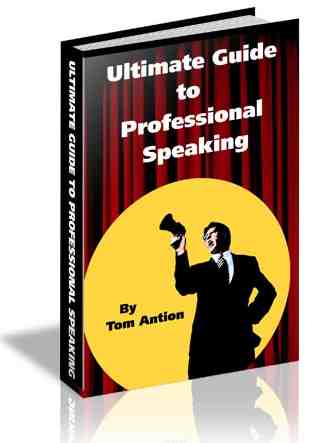Public Speaking:
Glossary P - T
PA: Abbreviation for public address system.
Panel: A group of presenters, normally seated, that hold a discussion on a particular subject. Audience members are invited to pose questions to individual presenters or to the group as a whole.
Parody: A humorous imitation of a serious piece of literature or song.
Planned spontaneity: See Canned ad-lib.
Plant: A person pretending to be a normal audience member, who, in fact, is there to assist the speaker in some way. Also Shill.
Platform: Raised area in front of the audience where the speaker stands. Also, Dais, Riser, Podium or Stage.
Pleonasm: The bringing together of two concepts or words that are redundant like frozen ice, sharp point, killed dead, sandy beach, young child, positive praise.
Plug: An informal advertisement made during a presentation used to promote a product or service.
Podium: See Platform. Many people call a lectern a podium. This is technically incorrect, but very common. Also Dais, Riser, or Stage.
Practical joke: A playful trick that usually puts the receiver in an embarrassing position. Also Prank.
Prank: A practical joke that could be good natured or malicious. See Practical joke.
Pratfall: In comedy, an on-purpose, exaggerated fall to the floor usually accompanied by flailing arms and legs for effect.
Pre-program questionnaire: Information gathering document used to customize a presentation.
Press kit: A package of information used to promote a speaker or performer.
Prompter: A device used to electronically display a magnified version of the script the speaker can see, but the audience can't. (Commonly called a
TelePrompter, which is actually a registered trade name.)
Prop: A shortened version of the theatrical term "property" used to describe any object handled or used by an actor in a performance.
Public address system: Abbrev. PA. The equipment used to amplify sound for the audience.
Public domain: Material that anyone can use without the need to give credit.
Public seminar: An educational event which is open to the public.
Pun: The humorous use of words that sound alike or nearly alike but are different in meaning as in Isn't this a punny book?
Punch line: The climactic word or phrase of a humorous statement that provokes laughter.
Q&A: Abbreviation for the question and answer portion of a presentation.
Click here for funny Q&A
session info
Click here for serious Q&A
session info
Rapport: A relationship with the audience, especially one of mutual trust or emotional attraction.
Rehearse: To practice for a presentation until all the rough spots are smoothed.
Relevance, Theory of: Belief that the only humor used in a business presentation should be related to the subject of the presentation, the speaker, the audience, or the location.
Repartee: A conversation full of quick, witty replies. Also Comeback, Riposte.
Repeat engagement: A second presentation for the same group.
Response to Introduction: After the introduction, comments directed to the introducer or the audience about the introduction or introducer.
Riposte: Sharp, quick action or reply. Also Comeback.
Riser: See Platform. Also, Dais, Podium or Stage.
Roast: An event where the guest of honor is ridiculed and teased in a good-natured, comical manner.
Roastmaster: The Master of Ceremonies at a roast.
Role play: An audience involvement exercise where the audience members and/or the presenter interact while assuming the attitudes and actions of others.
Rule of Three: Structure of humor where two serious items set a pattern then the third unexpectedly switches the pattern which provokes laughter, or three jokes on one topic in a bit.
Running gag: A gag that repeats itself or plays off a gag that occurred earlier.
Saver line: Comment made to recover from a (supposedly) humorous comment that failed.
Sarcasm: A cutting, often ironic, form of wit intended to make its victim the butt of contempt or ridicule
Segue: To move smoothly and unhesitatingly from one section or theme of a presentation to another. Pronounced
seg-way.
Self-effacing humor: A very powerful form of humor that highlights your own weaknesses.
Seminar: An educational session lasting from 30 minutes to several days.
Series: See Bits.
Shill: In comedy, a person planted in the audience to assist in a gag.
Shtick: A characteristic attribute, talent, or trait that is helpful in securing recognition or attention. In entertainment, a routine or gimmick attributed to a particular performer,i. e. smashing watermelons is part of Gallagher's (the comedian) shtick.
Sick humor: See Black humor.
Signature story: A story that is credited to a particular person. This type of story should never be used without attribution.
Simile: A comparison of two things which, however different in other respects, have some strong point or points in common. The words like and as will normally be used when making the comparison as in His brilliance is like a burned out light bulb.
Site: The location of the meeting. Also Venue.
Slapstick: Broad comedy involving boisterous action like throwing pies and fake violence ala The Three Stooges.
Slide: A 35mm transparency. Sometimes used to describe an overhead transparency.
Sound man (person): Person in charge of public address system, sound board, recording, etc. during a presentation.
Sound system: See Public Address System.
Speakers bureau: A service company that provides speakers for meeting planners.
Spokesperson: A person who speaks for or represents a company, organization or other person.
Stage: See Dais.
Stage fright: Nervousness associated with performing or speaking before an audience.
Stage left: As the performer faces the audience, the side of the stage to his/her left.
Stage lights: Lights illuminating the stage area only.
Stage right: As the performer faces the audience, the side of the stage to his/her right.
Stooge: An entertainer who feeds lines to the main performer and frequently is the butt of the joke.
Tailoring: Adjusting material to better suit a particular audience. Not quite customizing.
TelePrompter: See Prompter.
Test Humor: Humor used either in the introduction or early parts of a talk to determine the extent to which the audience is in fun.
Testimonial: A statement, usually written, in support of a another's character or worth; a personal recommendation.
Theater style seating: Seating where chairs are set in rows without tables.
Timing: Adjusting one's speaking and pausing for dramatic or comical effect.
Toastmaster: See Emcee.
Trainer: A person who conducts workshops and training sessions.
Transcribe: To make a written copy of a voice recording or presentation.
Transparency: A slide that is viewed by light shining through it from behind or by projection. Also Slide.
Two-step seminar: A free seminar where attendees are asked to buy a second seminar or purchase products.
(Public Speaking Glossary P - T) Click
here for Public Speaking U - Z






